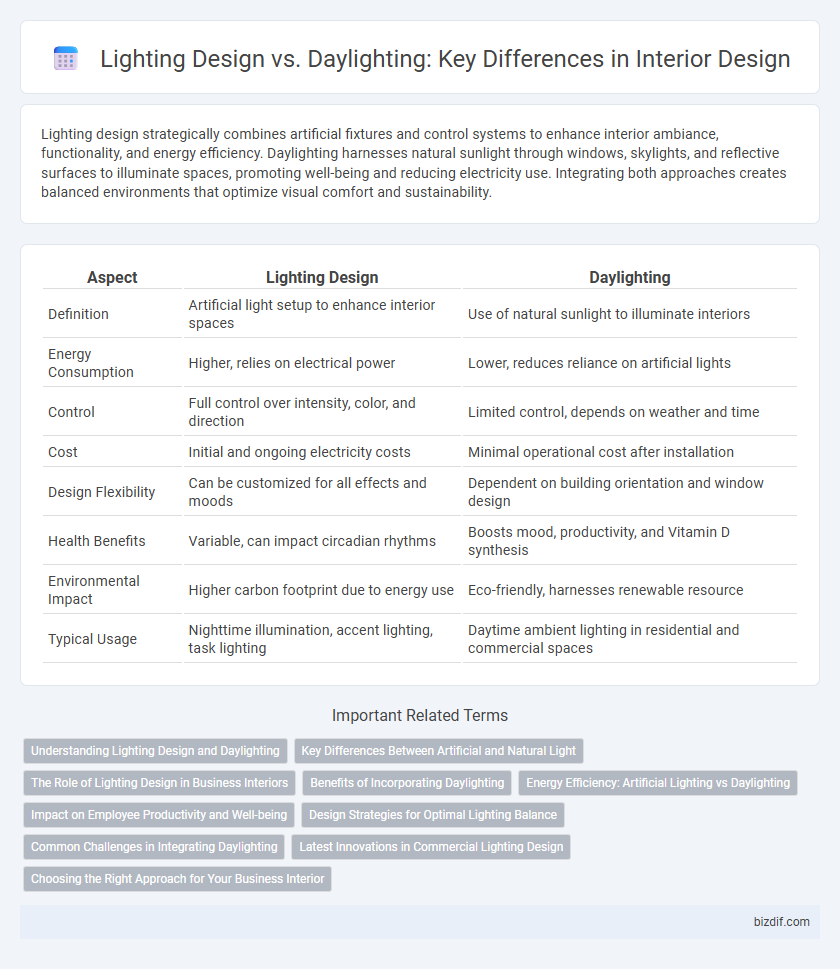Lighting design strategically combines artificial fixtures and control systems to enhance interior ambiance, functionality, and energy efficiency. Daylighting harnesses natural sunlight through windows, skylights, and reflective surfaces to illuminate spaces, promoting well-being and reducing electricity use. Integrating both approaches creates balanced environments that optimize visual comfort and sustainability.
Table of Comparison
| Aspect | Lighting Design | Daylighting |
|---|---|---|
| Definition | Artificial light setup to enhance interior spaces | Use of natural sunlight to illuminate interiors |
| Energy Consumption | Higher, relies on electrical power | Lower, reduces reliance on artificial lights |
| Control | Full control over intensity, color, and direction | Limited control, depends on weather and time |
| Cost | Initial and ongoing electricity costs | Minimal operational cost after installation |
| Design Flexibility | Can be customized for all effects and moods | Dependent on building orientation and window design |
| Health Benefits | Variable, can impact circadian rhythms | Boosts mood, productivity, and Vitamin D synthesis |
| Environmental Impact | Higher carbon footprint due to energy use | Eco-friendly, harnesses renewable resource |
| Typical Usage | Nighttime illumination, accent lighting, task lighting | Daytime ambient lighting in residential and commercial spaces |
Understanding Lighting Design and Daylighting
Lighting design involves the strategic placement and selection of artificial light sources to enhance functionality, aesthetics, and mood within interior spaces. Daylighting focuses on harnessing natural light through windows, skylights, and other openings to reduce energy consumption and create healthier environments. Effective interior design integrates both lighting design and daylighting principles to optimize illumination, comfort, and energy efficiency.
Key Differences Between Artificial and Natural Light
Lighting design primarily involves the strategic placement and selection of artificial light sources to enhance interior aesthetics and functionality, while daylighting optimizes the use of natural light through architectural elements like windows and skylights. Artificial light allows precise control over intensity, color temperature, and distribution, making it adaptable to various activities and moods regardless of time. In contrast, natural light varies with weather and time, offering benefits such as energy savings and biophilic effects but requiring careful management to prevent glare and heat gain.
The Role of Lighting Design in Business Interiors
Lighting design in business interiors enhances both functionality and aesthetics by strategically integrating artificial lighting to complement natural daylighting. Effective lighting design improves employee productivity, reduces energy consumption, and creates an inviting atmosphere that aligns with brand identity. Incorporating layers of light, including task, ambient, and accent lighting, ensures optimal visibility and mood throughout the workspace.
Benefits of Incorporating Daylighting
Incorporating daylighting in interior design significantly reduces energy consumption by maximizing natural light, which enhances occupant well-being and productivity through exposure to natural circadian rhythms. Daylighting also improves indoor air quality and aesthetic appeal by creating dynamic, inviting spaces that adapt to outdoor conditions. Strategic use of daylighting decreases reliance on artificial lighting, leading to lower utility costs and a sustainable building environment.
Energy Efficiency: Artificial Lighting vs Daylighting
Lighting design optimizes artificial light sources to reduce energy consumption while maintaining desired illumination levels, using technologies such as LEDs and smart controls. Daylighting harnesses natural sunlight through architectural features like windows, skylights, and light shelves to minimize reliance on artificial lighting during daytime hours. Integrating daylighting with efficient artificial lighting systems significantly enhances energy efficiency by lowering electricity use and reducing HVAC loads associated with heat from artificial lamps.
Impact on Employee Productivity and Well-being
Effective lighting design balances artificial lighting with daylighting to enhance employee productivity and well-being. Properly implemented daylighting reduces eye strain and boosts mood by regulating circadian rhythms, while optimized artificial lighting ensures consistent illumination during low natural light conditions. Studies reveal that workplaces with strategic lighting layouts experience up to a 15% increase in employee performance and a significant reduction in fatigue-related errors.
Design Strategies for Optimal Lighting Balance
Lighting design integrates artificial lighting techniques, focusing on fixture placement, light intensity, and color temperature to enhance interior aesthetics and functionality. Daylighting leverages natural light through window placement, skylights, and reflective surfaces to reduce energy consumption while maintaining visual comfort. Combining advanced lighting controls with daylight-responsive solutions achieves an optimal balance, promoting energy efficiency and occupant well-being in interior spaces.
Common Challenges in Integrating Daylighting
Integrating daylighting in interior design poses challenges such as glare control, inconsistent light levels throughout the day, and thermal gain management, which can impact occupant comfort and energy efficiency. Balancing artificial lighting with natural light requires careful planning to maintain optimal illumination without creating visual discomfort or increased HVAC loads. Effective daylighting strategies depend on window placement, glazing performance, and shading systems tailored to the building's orientation and use.
Latest Innovations in Commercial Lighting Design
Latest innovations in commercial lighting design integrate smart controls and energy-efficient LED systems to enhance both artificial lighting and daylighting strategies. Dynamic lighting solutions adjust intensity and color temperature in response to natural light levels, optimizing occupant comfort and reducing energy consumption. Advanced sensors and IoT technology enable seamless interaction between electric lighting and daylight harvesting, promoting sustainability and improving workspace productivity.
Choosing the Right Approach for Your Business Interior
Effective lighting design enhances workplace productivity and ambiance by strategically integrating artificial light sources tailored to specific business needs. Daylighting leverages natural light to reduce energy consumption and improve occupant well-being, but its success depends on building orientation, window placement, and climate conditions. Selecting the right balance between lighting design and daylighting involves assessing factors like operational hours, interior layout, and sustainability goals to optimize visual comfort and energy efficiency.
Lighting Design vs Daylighting Infographic

 bizdif.com
bizdif.com